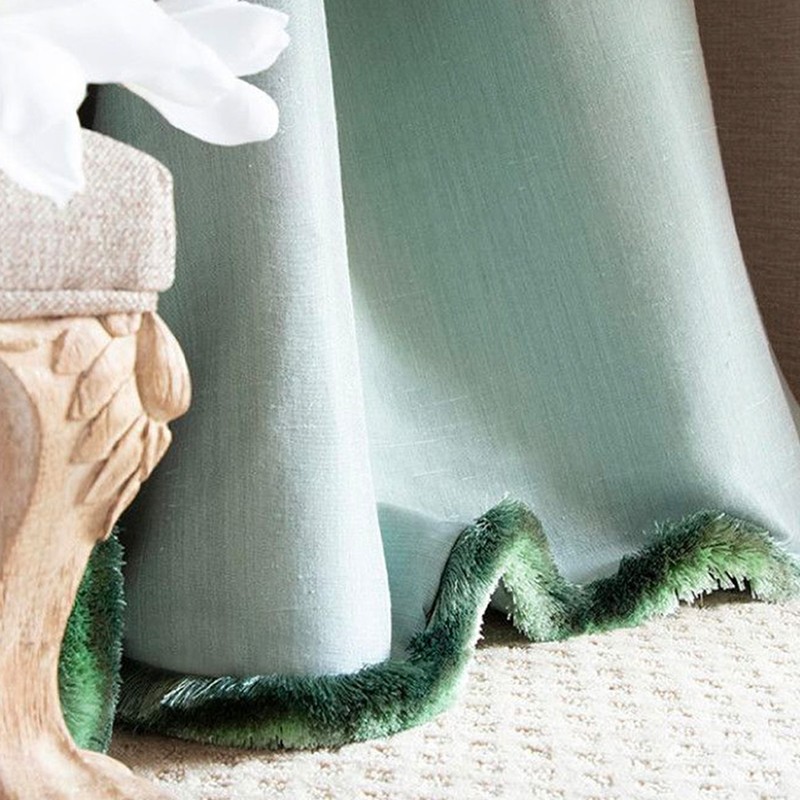How To Use Interior Trims In Your Home
What Does ‘Passementerie’ Mean?
“Passementerie comes from the French term for ornamental trimming and edging. It’s a catch-all term which includes braids, fringing, tassels, ropes, decorative buttons – the list is endless. Some are used for curtains, while others are used for upholstery.” – Philip Hooper, managing director at Sibyl Colefax & John Fowler
“While tassels and tiebacks may be the most well-known form of passementerie, various types of braids, borders, cords, ropes, fringe, rosettes, bows and tufts are all forms of ornamental applications which can be used on curtains, blinds and upholstery.” – Marisa Gutmacher, executive design director at Samuel & Sons
How Has It Been Used In The Past?
“Traditionally, passementerie was used to create a more ‘couture’ look. Through colour and proportion, you can use it to enhance the item you are trimming and create something more bespoke. Curtains without any detailing can look banal and unsophisticated, and similarly a sofa with a bullion fringe instead of a skirt will look more formal.” – Philip
What Kind Of Look Does It Create?
“Trimmings are as versatile as textiles in their aesthetic and can transform the ordinary into something more special. Generally, traditional-style trimmings serve both decorative and functional roles. Fine drapery will fall elegantly in place with the help of tiebacks; fabric edges will be preserved from the effects of sun; and upholstery seams are hidden and enhanced. Aesthetically speaking, pattern, colour and texture can enhance any scheme, regardless of style.” – Marisa
Why Might You Want To Use Passementerie?
“Passementerie can either be used as a form of embellishment or it can be functional. When recommending passementerie to designers, I encourage them to think about the intention. In other words, do you want the trimmings to draw your eye to a focal point through bold patterns or contrasting colours? Or should the trim recede by harmonising perfectly with the fabrics it’s paired with? And is the selected style, pattern, colour and fibre suited to the fabric and furniture selections? There are all important things to think about.” – Marisa
How Has Passementerie Remained Relevant In Interiors?
“Passementerie has evolved over time and today, there are endless choices on offer. Fringes can be made from glass, wood, shells, hand-covered beads, pom poms or traditional tassels. From contemporary to transitional and the traditional, trimmings can do everything from accentuating the lines of window treatments to introducing new patterns, textures and accent colours.” – Marisa


How Can Passementerie Work In More Contemporary Settings?
“Passementerie can work in contemporary schemes if it’s used more minimally. While this could include a bold graphic border on upholstery or drapery or a fine chainette fringe along the bottom of a sofa, the most important consideration is to maintain the clean lines and aesthetic wherever possible.” – Marisa
Is There A Subtle Way To introduce Passementerie Into A Space?
“The subtlest way to introduce passementerie into a room is with a contrasting cord piping on a piece of upholstery. Or, if you want to go for something more dramatic, try using strips of braid woven together to create a new fabric collage.” – Philip
“Subtlety is something you achieve through pattern and colour. A tone-on-tone piping used in upholstery or down the leading edge of a drapery can create a beautiful, finished edge, while at the same time blending seamlessly with the textiles with which it’s paired. It’s all about attention to detail.” – Marisa
And What If You Want To Go More Dramatic?
“With passementerie, drama can be achieved with large-scale, bold graphic borders down the leading edge of a drape, a very elaborate fringe or combinations of patterns layered on top of each other, or even a statement tieback. Contrasting saturated colours can also infuse more drama into a space.” – Marisa
What Are Some Of The Current Trends In Passementerie?
“Overall, we’ve seen a new interpretation of ‘traditional’. The new ‘traditional’ style is more refined and luxurious, but there’s still room to mix different period pieces and colour palettes. We’re seeing real demand for skirt fringes, bold graphic geometric embroidered and applique borders, and unexpected material combinations.” – Marisa
“Current trends include embroidered wide braids and tapes, while the most popular way to use it is as a border to curtains.” – Philip
How Can You Use Passementerie On A Budget?
“I would not necessarily advise scrimping on the trim, braid or fringe, but instead invest in something that looks ornate and keep the main material of the upholstery more affordable. For example, use a deep bullion fringe to revamp an existing or high-street sofa or chair. This will instantly give a more sumptuous look. Saying that, there are ways to add an extra layer of detail or elegance. Don’t discard any leftover fabric from curtains, cushions or headboards, as these can always be used to create contrast piping for other items and it’s a great way to create a cohesive look. We recently added a double piping edge to some dining chairs using surplus fabric – it really finished and elevated the piece.” – interior designer Antonia Winkler von Stiernhielm
Finally, What Are Some Common Mistakes To Avoid?
“Always make sure that the weight of the fabric and passementerie are well suited to each other, as well as for the intended piece.” – Marisa
“Be wary of using shiny, cheap versions in synthetic yarns – they can look flashy and vulgar.” – Philip
Visit Studio-Anton.com for more information.
DISCLAIMER: We endeavour to always credit the correct original source of every image we use. If you think a credit may be incorrect, please contact us at info@sheerluxe.com.


